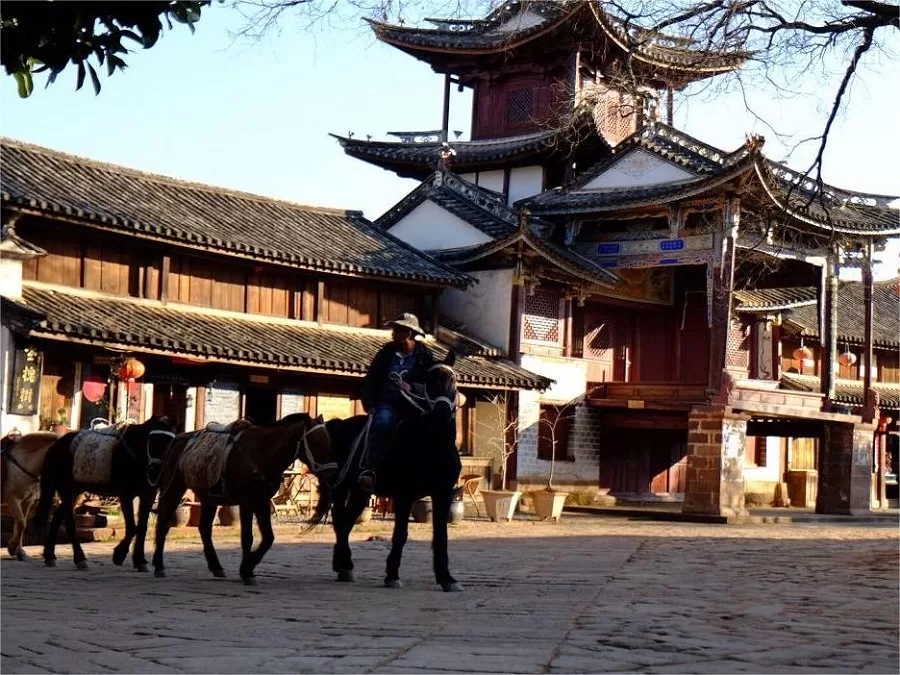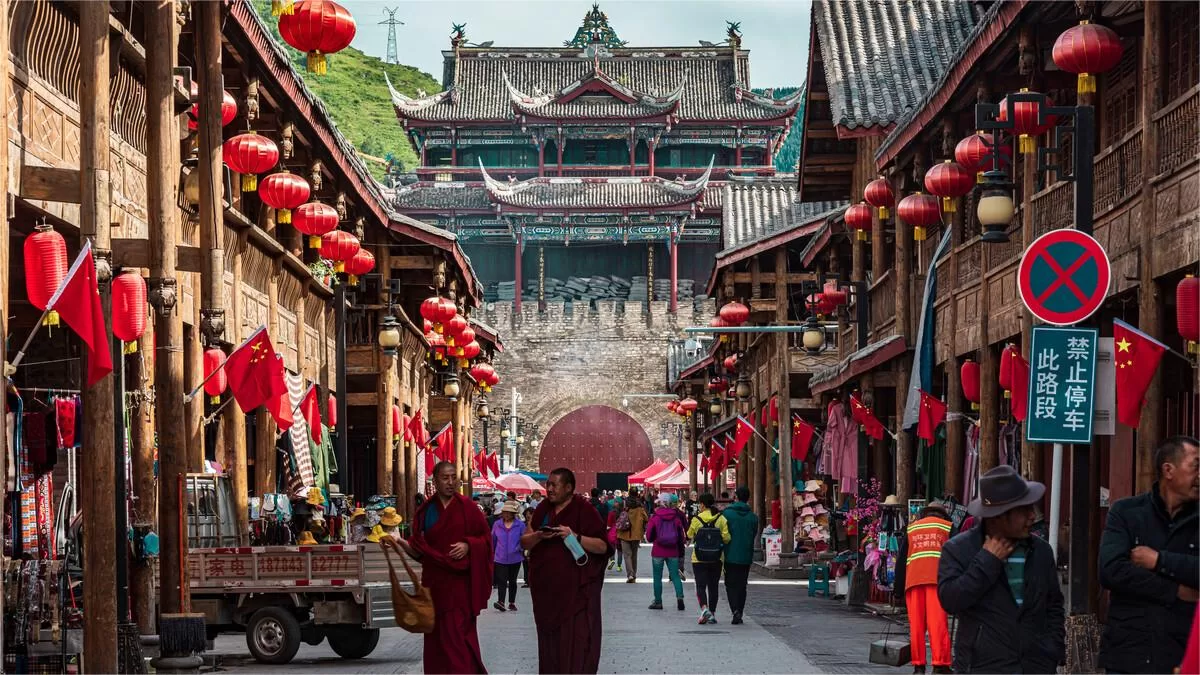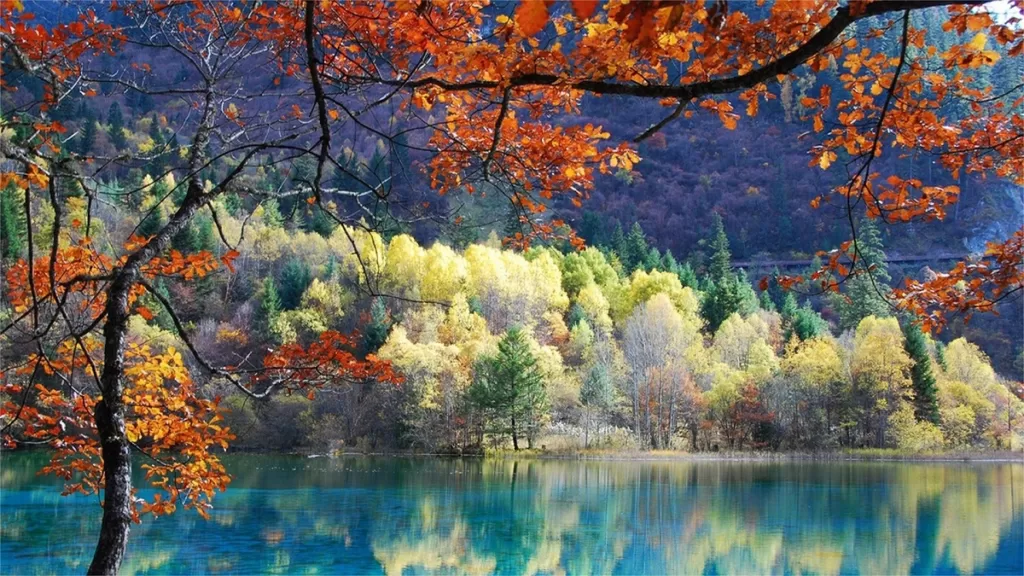Songpan Ancient Town (松潘古城, Songpan Ancient City), formerly known as Songzhou (松州), is nestled in the northeastern part of Aba Tibetan and Qiang Autonomous Prefecture in Sichuan Province, China. Its origins trace back to the Hongwu period of the Ming Dynasty, making it a historical gem with deep cultural roots. Throughout history, Songpan has played a dual role as a vital military stronghold in the northwest of Sichuan and a significant trading post for the Tibetan, Qiang, Hui, and Han ethnic groups engaged in the famous “Tea Horse Trade.”
Stepping into Songpan Ancient Town is like entering a realm where time stands still. The town’s ancient charm and tranquility allow visitors to leisurely wander among its historic buildings either on foot or by taking a ride on a human-powered tricycle. Here, one can trace the imprints left by centuries on this high-altitude ancient city, immersing themselves in the weight of its history and the stories it holds.
Climbing the ancient city walls provides a breathtaking panorama of the surrounding magnificent landscapes. Songpan Ancient Town offers a unique blend of cultural heritage and natural beauty, inviting travelers to experience the resilience and grace of a town that has witnessed the ebb and flow of time on the Tibetan Plateau. Whether exploring narrow alleyways, admiring ancient architecture, or savoring the panoramic views from the city walls, Songpan Ancient Town promises an enchanting journey into the heart of China’s rich cultural tapestry.
Table of Contents
- Basic Information
- Location and Transportation
- Highlights of Songpan Ancient Town
- Vlog about Songpan Ancient Town
- History of Songpan Ancient Town
- Useful Tips from Genuine Reviews
- Attractions near Songpan Ancient Town
Basic Information
| Estimated Length of Tour | Half a day |
| Ticket Price | The town is free, but you need to pay 45 RMB to ascend the city wall |
| Opening Hours | 24 hours a day |
Location and Transportation
Nestled within the picturesque valleys of the northern Sichuan province in China, Songpan Ancient Town is a hidden gem that beckons travelers with its timeless charm and awe-inspiring surroundings. Situated approximately 320 kilometers (199 miles) northwest of Chengdu, the provincial capital, Songpan Ancient Town enjoys a strategic location along the ancient Tea Horse Road, a historic trade route connecting China with Tibet and beyond.
Tourists from Chengdu can first take a coach at Chadianzi Bus Station (茶店子车站) and then transfer to a taxi at Songpan County to cover the remaining 2.5 kilometers.
Alternatively, you can take a high-speed train from Chengdu East Railway Station, get off at Zhenjiangguan Station (镇江关站), and transfer to the shuttle bus to Songpan Ancient Town.
Highlights of Songpan Ancient Town
Ancient City Wall

The ancient city wall of Songpan Ancient Town is a marvel of architectural resilience, dividing the town into inner and outer sections with connecting gates. Stretching over 6.2 kilometers, the wall stands 12.5 meters tall, constructed entirely with sturdy blue bricks. Its impressive thickness reaches 12 meters, making it one of the most robust city walls in the country. The town boasts seven gates, with “Jinyang Gate” to the east, “Yanxun Gate” to the south, “Weiyuan Gate” to the west, and “Zhenqiang Gate” to the north. The south gate of the outer city is known as “Buqing Gate,” still retaining its original intact archway. Additionally, there is a small west gate at the foot of the southwest mountain and an “Lingjiang Gate” along the outer city by the riverbank. While the early multi-eaved, hip-roofed city towers on the gates have unfortunately been damaged, the walls, except for four preserved gates, were reconstructed in 2004.
Traditional Houses

Traditional houses in Songpan Ancient Town epitomize architectural artistry and cultural heritage. These intricately designed dwellings showcase exquisite wooden carvings, intricate paintings, and graceful sloping roofs, reflecting the region’s distinct craftsmanship. These abodes were not only homes but also spaces where life unfolded, traditions were upheld, and stories echoed through generations. Stepping inside, you’re embraced by a sense of timelessness, where the past converges with the present.
Horse Trekking

Horse trekking in Songpan Ancient Town unveils an enchanting adventure through nature’s embrace. Mounted on sturdy steeds, you embark on a journey that winds through rolling meadows, tranquil river valleys, and ascending mountain trails. The rhythmic hoofbeats synchronize with your heartbeat, connecting you to the land’s pulse. Majestic peaks and pristine landscapes unfold around you, as the breeze carries whispers of centuries past. This equestrian exploration offers a unique perspective, blending the thrill of discovery with the serenity of the outdoors. Songpan’s horse trekking is a gateway to experiencing the region’s natural splendor and reliving the legacy of the ancient Silk Road traders who once traversed these very paths.
Vlog about Songpan Ancient Town
History of Songpan Ancient Town
Songpan Ancient Town, located in the northern part of Sichuan Province, boasts a rich history that dates back to the Tang Dynasty. During this period, the Tibetan leader Songzan Ganbu sent envoys to Chang’an to propose marriage. As the envoys passed through Songzhou, they were detained by local officials, which infuriated Songzan Ganbu. In retaliation, he led an army of 200,000 troops to invade, but the Tang general Han Xian was defeated. In response, Emperor Taizong dispatched the Minister of Personnel to lead the army to Songzhou. The Tang troops achieved a significant victory in the Battle of Chuanzhusi, forcing Songzan Ganbu to retreat. In a bid for peace, he later sent emissaries with gold to seek an alliance through marriage. Emperor Taizong, recognizing the importance of this alliance, married his daughter, Princess Wencheng, to Songzan Ganbu, a story that has become legendary.
Upon entering Songpan County, visitors are greeted by imposing ancient city walls and gates, well-preserved over centuries. According to the Songpan County Chronicles, in the twelfth year of the Hongwu reign of the Ming Dynasty (1379), General Ding Yu of the Pingqiang was tasked with suppressing the rebellion led by Dong Tieli. After conquering the rebellious forces, he advanced north and proposed to the emperor Zhu Yuanzhang the establishment of a military garrison in Songzhou.
When Songzhou was established as a garrison, Ding Yu appointed Gao Xian from Ningzhou Wei to oversee the construction of the city walls. This monumental task involved building walls along the foothills and riverbanks, taking five years to complete. The ancient bricks used in the walls measured 50 cm long, 25 cm wide, and 12.5 cm thick, made from a mixture of glutinous rice, lime, and tung oil. Each brick weighed about 30 kilograms, contributing to a towering wall that reached over ten meters high and extended for more than 6,200 meters. Remnants of ancient kilns used for brick-making can still be found in the surrounding hills.
During the reign of Emperor Yingzong of the Ming Dynasty (1436-1449), a civil uprising broke out in Songpan. The rebels, positioned atop the Western Mountains, had a clear view of the city’s defenses. After quelling the rebellion, the inspector Guan Chen was responsible for reinforcing the western city wall, extending it from the foothills to the mountain top. In the fifth year of the Jiajing reign (1526), the commander of Songpan further expanded the outer city by more than 1,000 meters, a project that took 60 years to bring the fortifications to their current scale.
Songpan Ancient Town is equipped with seven gates: the eastern gate is named “Jinyang,” the southern gate is called “Yanxun,” the western gate is known as “Weiyuan,” and the northern gate is “Zhenqiang.” Additionally, the southwestern foothills feature a smaller western gate, while the outer city has two gates oriented east-west and north-south called “Lianjiang” and “Fuqing,” respectively. Each gate is adorned with large, six-sided stone arches, the tops of which are semi-circular. The foundations of the gates feature intricate carvings and patterns that reflect the skill of ancient craftsmen. A stone wall near Lianjiang Gate bears an inscription from the sixteenth year of the Chongzhen reign (1643) announcing tax reductions.
The construction of the ancient city wall gates began in the twelfth year of the Hongwu reign when Songzhou Wei and Panzhou Wei were merged into Songpan Wei. The gate arches are fifteen feet thick, built to withstand the test of time and weather, having survived hundreds of years of exposure without significant erosion. Climbing the city walls offers breathtaking views of the surrounding landscapes.
Inside the ancient town, a picturesque scene unfolds with small bridges and flowing streams. A clear, rushing river meanders from the eastern edge of Songpan Ancient Town, flowing westward through the city. After passing through the main street, it turns south and exits the town near the southern gate. The lively atmosphere is further enhanced by traditional bamboo houses built along the riverbanks, allowing residents and visitors to appreciate the natural beauty of the nearby mountains and waters.
Songpan is also an important historical site. During the Xianfeng era of the Qing Dynasty, heavy taxation led to a massive uprising by the Tibetan and Qiang people against Qing rule. This revolt lasted six years, led by the heroic Qiang woman, E Neng Zuo. The uprising forces captured Jiu Guan Liu Bao and occupied Songpan Ancient Town for two years, defeating Qing troops multiple times and inflicting heavy casualties.
In addition to its historical significance, Songpan is a vital revolutionary memorial site. During the Long March, the Central Committee of the Communist Party of China held five significant meetings, two of which (the Shawo and Mao’er Gai meetings) took place in the Songpan area. To commemorate the heroic achievements of the Red Army during the Long March and to promote its spirit, the Central Committee and the Central Military Commission designated a site for the construction of the Long March Memorial Park in the town of Chuanzhusi.
The main memorial stele stands prominently on the summit of Yuanbao Mountain in Chuanzhusi Town, flanked by snow-capped peaks and forests, facing lush grasslands. The main stele, towering at 41.3 meters, features a 14.8-meter bronze statue of a Red Army soldier at the top, holding a flower in one hand and a gun in the other, with arms raised in a “V” shape, symbolizing the great victory of the Long March. The stele is adorned with 450 bronze alloy plates, taking on a triangular shape, representing the three main forces of the Red Army—the First, Second, and Fourth Front Armies—advancing northward to resist Japan.
The memorial base is encircled by a white jade-like stone line, with green lawns surrounding the site, symbolizing the phrase “snow-capped mountains, grasslands, and trees stand as monuments.” The park also features China’s largest modern art group sculpture, illustrating the arduous journey of the Red Army during the Long March. This impressive sculpture stretches 72 meters long, 8 meters wide, and reaches a height of 12.5 meters, crafted from 1,160 cubic meters of red granite, blending the glorious revolutionary history with the allure of modern art.
Useful Tips from Genuine Reviews
Local Specialty – Yak Meat Hot Pot: The local specialty, yak meat hot pot, is highly recommended.
Proximity to Nearby Attractions: Songpan is approximately 40 kilometers away from Huanglong Scenic Area, reachable in less than an hour by car. It’s around 150 kilometers from Jiuzhaigou, taking about 2.5 hours by car.
Authenticity of the Ancient Town: Compared to other highly commercialized ancient towns, Songpan Ancient Town is praised for retaining a more authentic atmosphere. The town still hosts many indigenous people and artisans who gather there. Visitors can buy authentic items from them.
Abundance of Yak Meat Skewers: Many establishments within the scenic area offer yak meat skewers, freshly cut, at around 10 yuan for 8 skewers. Trying these skewers is recommended.






